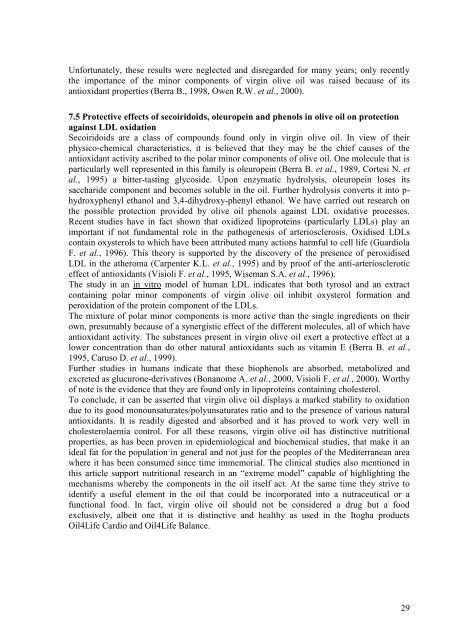Oil for Life to Balance omega-3 polyunsaturated fatty acids ... - Oil4Life
Oil for Life to Balance omega-3 polyunsaturated fatty acids ... - Oil4Life
Oil for Life to Balance omega-3 polyunsaturated fatty acids ... - Oil4Life
You also want an ePaper? Increase the reach of your titles
YUMPU automatically turns print PDFs into web optimized ePapers that Google loves.
Un<strong>for</strong>tunately, these results were neglected and disregarded <strong>for</strong> many years; only recently<br />
the importance of the minor components of virgin olive oil was raised because of its<br />
antioxidant properties (Berra B., 1998, Owen R.W. et al., 2000).<br />
7.5 Protective effects of secoiridoids, oleuropein and phenols in olive oil on protection<br />
against LDL oxidation<br />
Secoiridoids are a class of compounds found only in virgin olive oil. In view of their<br />
physico-chemical characteristics, it is believed that they may be the chief causes of the<br />
antioxidant activity ascribed <strong>to</strong> the polar minor components of olive oil. One molecule that is<br />
particularly well represented in this family is oleuropein (Berra B. et al., 1989, Cortesi N. et<br />
al., 1995) a bitter-tasting glycoside. Upon enzymatic hydrolysis, oleuropein loses its<br />
saccharide component and becomes soluble in the oil. Further hydrolysis converts it in<strong>to</strong> phydroxyphenyl<br />
ethanol and 3,4-dihydroxy-phenyl ethanol. We have carried out research on<br />
the possible protection provided by olive oil phenols against LDL oxidative processes.<br />
Recent studies have in fact shown that oxidized lipoproteins (particularly LDLs) play an<br />
important if not fundamental role in the pathogenesis of arteriosclerosis. Oxidised LDLs<br />
contain oxysterols <strong>to</strong> which have been attributed many actions harmful <strong>to</strong> cell life (Guardiola<br />
F. et al., 1996). This theory is supported by the discovery of the presence of peroxidised<br />
LDL in the atheroma (Carpenter K.L. et al., 1995) and by proof of the anti-arteriosclerotic<br />
effect of antioxidants (Visioli F. et al., 1995, Wiseman S.A. et al., 1996).<br />
The study in an in vitro model of human LDL indicates that both tyrosol and an extract<br />
containing polar minor components of virgin olive oil inhibit oxysterol <strong>for</strong>mation and<br />
peroxidation of the protein component of the LDLs.<br />
The mixture of polar minor components is more active than the single ingredients on their<br />
own, presumably because of a synergistic effect of the different molecules, all of which have<br />
antioxidant activity. The substances present in virgin olive oil exert a protective effect at a<br />
lower concentration than do other natural antioxidants such as vitamin E (Berra B. et al.,<br />
1995, Caruso D. et al., 1999).<br />
Further studies in humans indicate that these biophenols are absorbed, metabolized and<br />
excreted as glucurone-derivatives (Bonanome A. et al., 2000, Visioli F. et al., 2000). Worthy<br />
of note is the evidence that they are found only in lipoproteins containing cholesterol.<br />
To conclude, it can be asserted that virgin olive oil displays a marked stability <strong>to</strong> oxidation<br />
due <strong>to</strong> its good monounsaturates/polyunsaturates ratio and <strong>to</strong> the presence of various natural<br />
antioxidants. It is readily digested and absorbed and it has proved <strong>to</strong> work very well in<br />
cholesterolaemia control. For all these reasons, virgin olive oil has distinctive nutritional<br />
properties, as has been proven in epidemiological and biochemical studies, that make it an<br />
ideal fat <strong>for</strong> the population in general and not just <strong>for</strong> the peoples of the Mediterranean area<br />
where it has been consumed since time immemorial. The clinical studies also mentioned in<br />
this article support nutritional research in an “extreme model” capable of highlighting the<br />
mechanisms whereby the components in the oil itself act. At the same time they strive <strong>to</strong><br />
identify a useful element in the oil that could be incorporated in<strong>to</strong> a nutraceutical or a<br />
functional food. In fact, virgin olive oil should not be considered a drug but a food<br />
exclusively, albeit one that it is distinctive and healthy as used in the I<strong>to</strong>gha products<br />
<strong>Oil</strong>4<strong>Life</strong> Cardio and <strong>Oil</strong>4<strong>Life</strong> <strong>Balance</strong>.<br />
29


